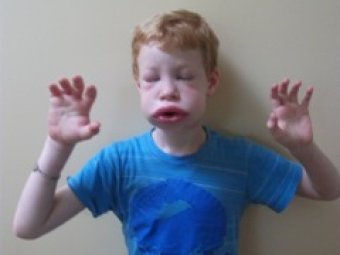Sufferers of a chronic genetic condition say Australia is lagging behind world standards in diagnosing and treating the disease.
Hereditary angioedema (HAE) is a rare, potentially life-threatening disease that allows the body’s immune response to attack blood vessels.
It causes severe swelling of the face, hands, feet and abdomen and is often triggered by stress but experts say what sufferers fear most is swelling of the airways.
Patient advocacy group HAE Australasia has compared Australia’s performance in diagnosing and treating the disease against 20 recommendations set out by the World Allergy Organisation (WAO).
It found Australia is lagging behind and major improvements are required in 14 of the 20 outlined.
Immunologist and allergy expert Dr Connie Katelaris said without immediate treatment people could suffocate and die.
Before effective therapy, about one in three patients suffocated.
“It is a devastatingly frightening condition from that point of view and many people although they’re not swelling all the time, live with that fear every day,” she said.
About 120 Australians have been diagnosed with the disease, but Dr Katelaris said the real number was more likely closer to 500.
She said misdiagnosis and a lack of awareness meant many people had no idea they were living with the condition.
“This is an incredibly rare disorder and most doctors won’t see a patient with this in their working lifetime,” she said.
Condition causes ‘quite horrendous pain’
Tom Flynn, 72, was diagnosed at the age of 38 after decades of unexplained pain and swelling.
“I used to get a lot of pains in the stomach – swollen stomachs, occasionally blocked bowel – and the pain was quite horrendous,” he said.
“That would last for about a day to three days.”
He is among an even rarer group of people who contracted the disease through a gene mutation during conception.
“The problem now is it’s hereditary,” he said.
Two of his three children and two grandchildren, have the condition.
Grandson Ryan Bogoyevitch, 12, of Sunnybank Hills in Brisbane, has just been discharged from hospital for the 25th time this year.
“I’ve kept records recently for being in every week,” Ryan said.
“I’m not enjoying that at all. I’ve counted 169 needles in total.”
It has also meant he has been forced to regularly miss school and give up sports.
His mother Tania Bogoyevitch said she knew exactly what he had been going through, as she remembered suffering an attack as a child when her tongue and airways swelled.
She heard doctors saying that if she could not make a sound they would have to perform a tracheostomy. Her mother later admitted she had nearly died.
‘Proper treatment and affordable medication a problem’
Dr Katelaris said Australia’s problems with treatment mainly related to having access to appropriate and affordable medication.
HAE Australasia group president Fiona Wardman, who also has the condition, said a simple genetic test could show if someone had the disease.
“It’s raising awareness to know that all the different types of swelling that you can have the internal and external, letting people know what those symptoms are,” she said.
“And then hopefully getting them off to a GP then an immunologist who treats the disorder and getting them onto the right treatment.”
For Mr Flynn, the drive to find out the cause of his condition came from seeing his two children suffer.
“There has been tremendous advancement, I believe, in doctor awareness,” he said.
“They’ve made tremendous advances now in the different medications that are available.
“Unfortunately, they’re so expensive. But, I live in hope that while I might not see it in my lifetime, there’ll be a – not so much a cure – but a treatment.”


